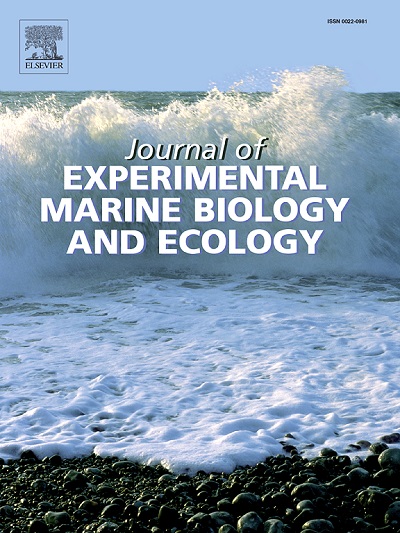母鱼、温度和季节对波罗的海西部大西洋鲱鱼黄囊幼虫的影响
IF 1.8
3区 生物学
Q3 ECOLOGY
Journal of Experimental Marine Biology and Ecology
Pub Date : 2025-05-24
DOI:10.1016/j.jembe.2025.152109
引用次数: 0
摘要
在一年中的特定时间产卵的海洋鱼类中,母体效应与季节性非生物因素相互作用,影响后代的表型,从而影响生命早期阶段的生长、发育和生存。母体与非生物过程在个体发育中的相对重要性尚不清楚。我们在早(7°C)和晚(13°C)的原位温度下孵育了22只大西洋鲱鱼(Clupea harengus)雌性鲱鱼的后代,这些雌性鲱鱼分别来自早、中、晚春产卵期。卵囊幼虫孵化后,跟踪卵囊面积、脊索长度、体深、体面积和畸形情况的变化,直到不返回点(超过此点饥饿是不可逆的),也可以估计体细胞生长速度和蛋黄利用效率。然后,我们量化了母体效应、孵化温度和季节效应对后代性状的贡献。在新孵化的幼虫中,体温(18%)和季节(12%)可以解释体面积的变化,而不是母亲的影响。当卵囊幼虫达到最大尺寸时,卵大小和个体雌虫合计占体面积变异的三分之二以上(77%),而季节和温度的影响不能解释额外的变异。然而,母性效应与雌性体型无关(全长26.0-31.3 cm)。结果表明,雌虫与卵、卵囊幼虫的尺寸级匹配度较差(14 ~ 36%),而卵与最大幼虫的尺寸级匹配度较好(59%),与新孵化幼虫的尺寸级匹配度较低(36%)。此外,相对于整个卵黄期,晚熟和13°C处理的卵黄囊幼虫在孵化后自由游动的卵黄囊期相对较长。不同季节和温度处理的蛋黄利用效率相似,畸形率较低(5.3%)。综上所述,我们的研究表明,在从内食到外食的过渡时期,季节对后代大小的影响归因于卵大小的差异,雌性鲱鱼在这个季节产卵较早,产卵量较大。本文章由计算机程序翻译,如有差异,请以英文原文为准。
Maternal, temperature, and seasonal effects on yolk-sac larvae of Atlantic herring Clupea harengus in the western Baltic Sea
In marine fishes that spawn at specific times of the year, maternal effects interact with seasonal abiotic factors to influence offspring phenotypes that can affect growth, development, and survival of the early life stages. The relative importance of maternal versus abiotic processes throughout ontogeny is unclear. We incubated the progeny of 22 Atlantic herring Clupea harengus females from either early-, mid-, or late-spring spawning periods at both early- (7 °C) and late-season (13 °C) in situ temperatures. After yolk-sac larvae had hatched, changes in yolk sac area, notochord length, body depth, somatic body area, and cases of deformities were tracked until the point-of-no-return (beyond which starvation is irreversible), also allowing somatic growth rate and yolk utilization efficiency to be estimated. We then quantified the contributions of maternal effects, incubation temperature, and seasonal effects on offspring traits. Among newly-hatched larvae, the variance in body area was explained by temperature (18 %) and seasonal (12 %) but not maternal effects. As yolk-sac larvae reached maximum size, egg size and individual females together accounted for more than two-thirds (77 %) of the variance in body area, while seasonal and temperature effects did not explain additional variance. The maternal effects were, however, unrelated to female size (total length of 26.0–31.3 cm). As a result, size classes of females matched poorly (14–36 %) with those of egg and yolk-sac larval stages, while size classes of eggs matched well with those of maximum-sized larvae (59 %) and less with those of newly-hatched larvae (36 %). Furthermore, yolk-sac larvae from later in the season or from the 13 °C treatment had a relatively longer post-hatch, free-swimming yolk-sac larval stage with respect to the whole yolk period. Yolk utilization efficiency was similar and deformity percentage was low (<5.3 %) across seasonal timing and temperature treatments. In conclusion, our study revealed that the seasonal effects on offspring size at the transition period from endo- to exogenous feeding were attributed to differences in egg size, with herring females spawning earlier in the season producing larger eggs.
求助全文
通过发布文献求助,成功后即可免费获取论文全文。
去求助
来源期刊
CiteScore
4.30
自引率
0.00%
发文量
98
审稿时长
14 weeks
期刊介绍:
The Journal of Experimental Marine Biology and Ecology provides a forum for experimental ecological research on marine organisms in relation to their environment. Topic areas include studies that focus on biochemistry, physiology, behavior, genetics, and ecological theory. The main emphasis of the Journal lies in hypothesis driven experimental work, both from the laboratory and the field. Natural experiments or descriptive studies that elucidate fundamental ecological processes are welcome. Submissions should have a broad ecological framework beyond the specific study organism or geographic region.
Short communications that highlight emerging issues and exciting discoveries within five printed pages will receive a rapid turnaround. Papers describing important new analytical, computational, experimental and theoretical techniques and methods are encouraged and will be highlighted as Methodological Advances. We welcome proposals for Review Papers synthesizing a specific field within marine ecology. Finally, the journal aims to publish Special Issues at regular intervals synthesizing a particular field of marine science. All printed papers undergo a peer review process before being accepted and will receive a first decision within three months.

 求助内容:
求助内容: 应助结果提醒方式:
应助结果提醒方式:


